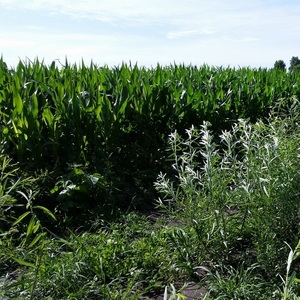Argonne scientists study benefits of bioenergy crop integration

Patty Campbell
August 6, 2015
BY U.S. DOE's Office of Energy Efficiency and Renewable Energy
How can our landscapes be managed most effectively to produce crops for food, feed, and bioenergy, while also protecting our water resources by preventing the loss of nutrients from the soil? Dr. Cristina Negri and her team at the U.S. Department of Energy’s Argonne National Laboratory are tackling this question at an agricultural research site located in Fairbury, Illinois.
Scientists at Argonne National Laboratory, funded by the U.S. Department of Energy’s Bioenergy Technologies Office, are studying multifunctional landscapes and how they can benefit farmers, the environment, and the bioenergy industry nationwide. Their study, “Multifunctional landscapes: Site characterization and field-scale design to incorporate biomass production into an agricultural system,” is set to be published in September 2015 in the journal, Biomass and Bioenergy. Watch a short video about their research.
Advertisement
The team, led by Cristina Negri, ANL’s principal agronomist and environmental engineer, has been examining the environmental and economic benefits of co-planting bioenergy crops with commodity crops, such as corn, in a pilot field in the Indian Creek Watershed in Illinois. To test the bottom line of multifunctional landscapes compared to traditional dedicated crop fields, the team identified unproductive and low-yield areas of cornfields and planted bioenergy crops there instead. These low-yield cornfield areas result in lower profits for farmers. Deep-rooted and perennial bioenergy crops, such as willows and switchgrass, could be grown in these areas in contour buffer strips.
The co-planting showed promising results for reducing nitrogen compound runoff and increasing bioenergy willow yield without the use of extra fertilizer. Without co-planting, areas of low corn yield decrease profits and are an inefficient use of fertilizer. Excess nitrogen from the wasted fertilizer leaches into the watershed, which is detrimental to air and groundwater and disrupts aquatic ecosystems. It also contributes to greenhouse gas emissions. However, the deeper roots of bioenergy crops are able to capture excess fertilizer from the cornfield, reducing leached nitrogen.
Advertisement
ANL post-doctoral researcher Herbert Ssegane said he is hopeful that the results of this study will provide one more practical, sustainable, and profitable land management practice for farmers to adopt. This work by ANL is just one example of how BETO is committed to supporting a sustainable and robust national bioeconomy. Learn more these efforts in BETO’s Sustainability Fact Sheet.
Related Stories
U.S. fuel ethanol capacity fell slightly in April, while biodiesel and renewable diesel capacity held steady, according to data released by the U.S. EIA on June 30. Feedstock consumption was down when compared to the previous month.
The U.S. EPA on July 8 hosted virtual public hearing to gather input on the agency’s recently released proposed rule to set 2026 and 2027 RFS RVOs. Members of the biofuel industry were among those to offer testimony during the event.
The USDA’s Risk Management Agency is implementing multiple changes to the Camelina pilot insurance program for the 2026 and succeeding crop years. The changes will expand coverage options and provide greater flexibility for producers.
The USDA’s National Agricultural Statistics Service on June 30 released its annual Acreage report, estimating that 83.4 million acres of soybeans have been planted in the U.S. this year, down 4% when compared to 2024.
SAF Magazine and the Commercial Aviation Alternative Fuels Initiative announced the preliminary agenda for the North American SAF Conference and Expo, being held Sept. 22-24 at the Minneapolis Convention Center in Minneapolis, Minnesota.
Upcoming Events










